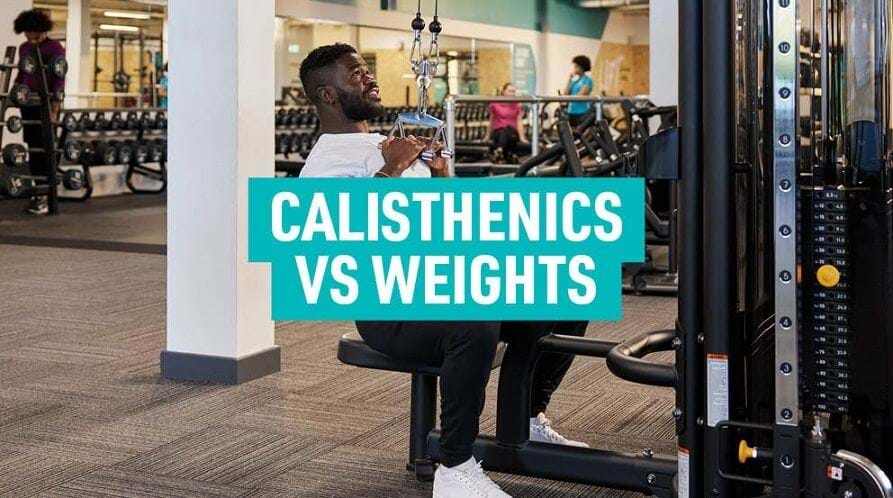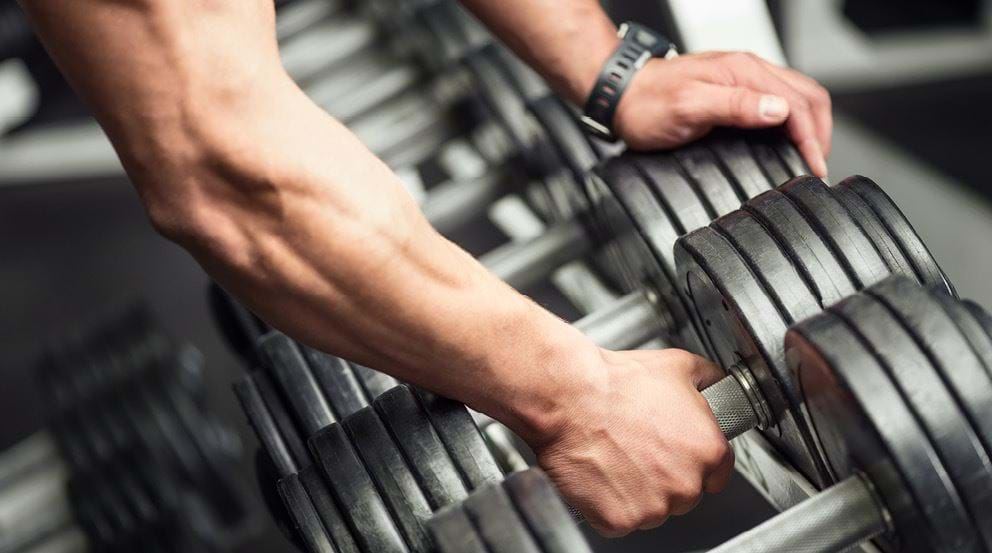Calisthenics Vs Weights: Which is Better?

The Differences | Calisthenics vs Free Weights | Best for Building Muscle? | Best for Weight Loss? | Pros and Cons of Calisthenics | Pros and Cons of Weight Training
Calisthenics and weight training are two very different forms of strength training. Calisthenics is a form of bodyweight strength training were bodyweight and gravity provide resistance, whereas weight training uses weights to provide the resistance.
It has long been debated in the fitness industry as to which is better, however this isn't a straightforward answer as it depends on what you're looking to achieve. Are you focusing on building raw muscle mass and strength? Or are you looking to improve your body's overall functionality and definition?
Alongside the help and input of PureGym PT Joshua Lindner, we'll look at the benefits and approaches to both calisthenics and weights to help you find the best fitness path to reach your goals.
The Difference Between Lifting Weights And Calisthenics
The most obvious difference between lifting weights and calisthenics is how resistance is created. Weightlifting uses external weights, including free weights such as dumbbells, barbells, and kettlebells, and gym machines including cable machines and fixed resistance machines.
In contrast, calisthenics uses bodyweight and gravity to provide resistance to the muscles. Many calisthenics exercises require no equipment, although paralettes, dip bars, and pull up bars can be used along with resistance bands to make exercises more or less challenging.
The types of exercises also tend to differ between the two disciplines. Weight lifting generally consists of both compound (multi joint) movements like squats and deadlifts, as well as isolation exercises that target one muscle such as bicep curls. Calisthenics tends to exclusively consist of compound exercises, often with a much larger range of motion.
Calisthenics Vs Free Weights: Which Is More Effective?
That depends on what you are trying to achieve. For some goals, calisthenics can be more effective, and for others weightlifting is the better choice. We'll look at some training objectives in more detail below, and which style of training works better for these.
Regardless of your choice, both are great for training strength and can be combined to create a versatile workout plan that builds muscle and definition.
Is Calisthenics Or Weightlifting Better For Building Muscle
While calisthenics can help to build muscle, weight training is generally considered a better choice than calisthenics when muscle hypertrophy is the goal.
To build muscle, you need to continually provide enough challenge to the muscles to force adaptation. Known as progressive overload, this involves causing microscopic tears in the muscle fibres. When the body repairs these tears, they make the muscle fibres bigger and stronger, leading to an increase in muscle mass over time.
Weight training allows more control over resistance, making it easier to progressive overload the muscles. All you need to do is increase the weights over time and you are progressively overloading. Weight training also has more ways to target individual muscles. Adding isolation exercises like tricep extensions to your training can be an easy to encourage muscle growth.
As calisthenics relies on bodyweight to provide resistance, you can reach a point where you are no longer providing enough challenge to stimulate muscle growth without performing dozens of reps. Moving to more challenging variations of an exercise is a common way to advance in calisthenics, but this can take a long time to achieve. For example, it's much easier to add 2kg on to bench press than it is to progress from push ups to one arm push ups.
If your main or only goal from working out is to increase your size, weightlifting is the easier route.
Which Is Better For Weight Loss?
Weight loss happens when you consume less calories than you burn, and it's worth noting that the best way to do this is through creating a calorie deficit in your diet rather than exercising. That said, exercise can help to increase how many calories you burn each day to support weight loss.
Calisthenics is generally much more dynamic than weightlifting and requires more movement, making it the winner when it comes to burning calories. The nature of calisthenics also lends itself well to high-intensity interval training (HIIT) or circuit training too, which boosts calories burned even further.
While weightlifting likely burns less calories per workout, it does have some benefits to weight loss, including protecting muscle from being burnt instead of fat, and improving overall metabolism by increasing muscle mass.
Staying active consistently is more important than the type of activity when it comes to weight loss, so for this goal we'd recommend trying both workouts and seeing which you're more likely to stick with.
Pros & Cons Of Calisthenics
Let's take a look at some of the main pros and cons of calisthenics training:
Pros
Improved Muscle Tone
Calisthenics exercises are an effective way to work the muscles, and while it's harder to increase mass with this style of training, calisthenics will improve muscle size and tone.
More functional strength
Most calisthenics exercises involve multiple muscle groups working together which reflects how we use our bodies in real life. Calisthenics improves your ability to move and control your bodyweight, which can make everyday movements much easier.
Increased balance, coordination, and stability
Calisthenics challenges the core and smaller stabilising muscles while teaching the different body parts to work in sync. This builds overall balance, coordination and stability as well as full body strength.
Improved flexibility and mobility
A lot of calisthenics exercises prioritise full range of motion, and strength at end range. This improves flexibility and mobility over time, leading to healthier muscles and joints and reduced risk of injury.
No need for equipment
While you can choose to use equipment, it's not necessary. This makes calisthenics an inexpensive and accessible way to work out, as you can train anywhere -- whether that's at home or in the park.
Can help with fat loss
Calisthenics can be an effective way to burn fat due to its high-intensity nature. It boosts metabolic rate and can be easily integrated into HIIT exercises.
Cons
Harder to progressive overload
Progressive overload isn't impossible with calisthenics, but it's harder to do, and as you get more advanced it becomes more challenging. If you enjoy calisthenics but want to still progress, you may want to consider adding weights to your workouts to aid progressive overload, for example weighted push ups and pull ups.
May not target all muscles equally
Calisthenics mainly focuses on multi muscle movements, and it can be harder to isolate individual muscles. While all muscles will be worked in some form, smaller muscles like the calves and biceps may not progress as fast as bigger muscles which tend to take over in exercises.
It can also be challenging to achieve significant lower body strength and hypertrophy without incorporating weights or specialised equipment.
Requires significant patience
Calisthenics can take longer to progress, especially when it comes to achieving advanced calisthenics skills such as muscle ups or planches. These often require a high degree of strength, mobility and control, and can take years to master. While some people enjoy the challenge, it can be discouraging for beginners and may lead to frustration.
Pros & Cons Of Weight Training
Pros
Increases muscle mass and strength
Regular strength training promotes muscle hypertrophy and neural adaptations, which leads to bigger muscle size and increased strength. It's also effective for reducing lower back pain and easing discomfort associated with arthritis and fibromyalgia, and has been shown to reverse specific ageing factors in skeletal muscle.
Enhances your metabolic rate
Studies have shown that weight training boosts resting metabolic rate, supporting weight management and fat loss.
Plus, inactive adults experience a 3% to 8% loss of muscle mass per decade, as well as a lower metabolic rate and higher fat gaing.. One study found that ten weeks of resistance training may increase lean weight by 1.4 kg, increase resting metabolic rate by 7%, and reduce fat weight by 1.8 kg.
Aids in chronic disease management
Resistance training may help with the prevention and management of type 2 diabetes by decreasing visceral fat, reducing HbA1c, increasing the density of glucose transporter type 4, and improving insulin sensitivity.
Improves bone density
Weight training has been shown to increase bone mineral density by 3%, reducing the risk of osteoporosis and fractures.
Enhances functional fitness
Weight training improves functional fitness, so you can find day-to-day activity easier, and are less likely to get injured. It also boosts balance, coordination, and mobility, crucial for maintaining independence in older adults.
Cons
Risk of injury
Weightlifting, especially when performed with improper form or excessive weights, can increase the risk of musculoskeletal injuries such as strains, sprains, and joint injuries.
No cardio benefits
Weightlifting is great for building strength but does not provide sufficient challenge to the cardiovascular system. If weight training is your sole form of exercise, you'll need to ensure you are performing cardio workouts too.
Requires equipment
Weightlifting, as you might imagine, requires access to specialised equipment such as barbells, dumbbells, and weight machines, which may not be readily available or accessible to everyone.
Can cause muscular imbalances if poor programming is used
Many weightlifters target certain muscles for aesthetics and neglect others which can lead to imbalances and injury risk. It's important to ensure your training focuses on all muscle groups, including smaller stabilising muscles that may not contribute to appearance.
Both calisthenics and weights are strong options for those looking to step up their fitness goals. Which is 'better', depends entirely on what you're looking to achieve. Most people can benefit from including both forms of training! You can learn more over on our What Type of Strength Training is Right for You guide.
The key to fitness is consistency and following a workout plan tailored to you. If you'd like help creating this or just some more advice on how to hit your goals, please speak to one of our personal trainers.
Alternatively, begin your workout journey at your nearest PureGym.


